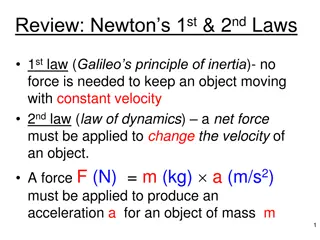Innovative Device-Free Passive Motion Detection System
This research presents RASID, a robust WLAN device-free passive motion detection system that can detect human presence without the need for carrying any devices or interacting actively with the system. By analyzing changes in received signal strength behavior, the system can identify human motions. The technology has potential applications in intrusion detection, smart homes, border protection, and enhancing security systems. Challenges include dealing with noisy signal readings, environmental changes, and high overhead in constructing signal profiles for motion and silence detection.
Download Presentation

Please find below an Image/Link to download the presentation.
The content on the website is provided AS IS for your information and personal use only. It may not be sold, licensed, or shared on other websites without obtaining consent from the author.If you encounter any issues during the download, it is possible that the publisher has removed the file from their server.
You are allowed to download the files provided on this website for personal or commercial use, subject to the condition that they are used lawfully. All files are the property of their respective owners.
The content on the website is provided AS IS for your information and personal use only. It may not be sold, licensed, or shared on other websites without obtaining consent from the author.
E N D
Presentation Transcript
RASID: A Robust WLAN Device-Free Passive Motion Detection System Ahmed E. Kosba , Ahmed Saeed , Moustafa Youssef Alexandria University, Egypt Egypt-Japan University for Science and Technology (E-JUST), Egypt
Outline Introduction device-based active systems device-free passive systems potential applications of device-free passive systems Challenges and Related Work Identifying Effective Signal Features RASID System Evaluation Summary
Device-Based Active System User carries a device Participates actively in the localization process GPS Cellular based WLAN signal strength based
Can we detect a user that is not carrying any devices and is not interacting with the system?
Observation No human presence Relatively stable received signal strength (RSS) behavior
Observation Human presence Changes in RSS behavior Could be used for human detection Device-free passive motion detection
Active vs. Passive Mobile device interacting with infrastructure Active Infrastructure components interacting with each other Passive
Potential Applications Intrusion detection Smart homes Border protection Assisting installed security systems
Outline Introduction Challenges and Related Work device-free passive systems challenges related work our contributions Identifying Effective Signal Features RASID System Evaluation Summary
Device-free Passive System Challenges Noisy signal readings Changing environment Constructing signals profiles once will not work Large overhead of constructing signal profiles for both motion and silence
Related Work Moving average detection [Youssef et al, Mobicom 07] detects RSS mean shifts Moving variance detection [Youssef et al, Mobicom 07] detects RSS variance changes human present vs. no human present Maximum likelihood Classification [Moussa et al, PerDev 09] learns RSS behavior in human presence and absence
Our Contributions Identifying best signal feature for motion detection Using anomalous behavior of RSS to detect human motion robust to changes in the environment robust parameters to different deployments Minimal deployment overhead without harming the system s performance
Outline Introduction Challenges and Related Work Identifying Effective Signal Features sensitivity to human motion resistivity to temporal variations RASID System Evaluation Summary
Feature Selection Received Signal Strength Mean vs. Received Signal Strength Standard Deviation Mean: a measure of central tendency Standard deviation: a measure of dispersion Compared according to two metrics sensitivity to human motion resistivity to temporal variation
Feature Selection (Sensitivity to Human Motion) Received Signal Strength Mean vs. Received Signal Strength Standard Deviation Distance between feature motion Histogram feature Silence Histogram Standard deviation is more sensitive to human motion
Feature Selection (Resistivity to Temporal Variation) Received Signal Strength Mean vs. Received Signal Strength Standard Deviation Distance between feature silence histogram feature silence histogram collected two weeks later Standard deviation is a better feature Standard deviation is less affected by temporal variations
Outline Introduction Challenges and Related Work Identifying Effective Signal Features RASID System system operation system architecture Evaluation Summary
System Operation Offline training phase constructs silence profile of RSS Online monitoring phase detects anomalous behavior of the RSS updates the constructed silence profile handles noisy readings
RASID Architecture Online Phase Offline Phase
Silence Profile Construction Calculates variance values of a moving sliding window over RSS readings Estimates density function of the variance using Kernel Density Estimation. Two minutes training phase
Basic Detection Module Decides if there is any anomaly for any new signal reading Critical Value Calculates an anomaly score for each stream, to express the significance of the generated alarms
Normal Profile Update Module The Environment Changes
Normal Profile Update Module Updates stored normal profile to account for changes in the environment Groups readings that are not anomalous on average Add the group to the silence profile Linear weights are used to give recent readings more weight in the normal profile And the density function becomes
Normal Profile Update Module The Environment Changes
Decision Refinement Module Studies the sum of the anomaly scores of all streams Uses Exponential Smoothing to avoid the noisy samples 70 Unsmoothed Smoothed Motion Periods 60 Sum of Anomaly Scores 50 40 30 20 10 0 0 500 1000 1500 Time (Seconds)
Region Tracking Interface Visualizes the output of the system on the map of the area of interest Identifies the regions of the detected entity Silence Motion
Outline Introduction Challenges and Related Work Identifying Effective Signal Features RASID System Evaluation experimental environment modules effect on performance RASID vs. earlier device-free passive systems Summary
Experiments Environment Testbed 1: an office with an area of 2000 ft2 Equipment: Four Cisco APs Three Dell Laptops with a D-Link Airplus G+ card Testbed 2: two floor home building of 1500 ft2 each Same equipment covering larger area
Experiments Environment Data Collection: One hour and 15 minutes of data was collected. Sampling rate of 1 sample/second Silence data and three motion sets collected Two minutes only training for the entire site
Evaluation Metrics False Positive (FP) rate probability that the system generates an alarm while there is no human motion False Negative (FN) rate probability that the system fails to detect the human motion F-measure a single value to measure the effectiveness of the detection system
Modules Effect on Performance Decision Refinement (RASID Overall Performance) Basic Detection Testbed 1 Profile Update F-measure 0.8683 0.8989 0.9574 Enhancement w.r.t. the F-measure - 3.52% 10.26% Testbed 2 F-measure 0.8167 0.8422 0.9311 Enhancement w.r.t. the F-measure - 3.1% 14% More than 10% gain in performance over basic module
Overall System Performance Decision Refinement (RASID Overall Performance) Testbed 1 FN Rate 4.6% High performance with low overhead Same parameters used parameters robustness FP Rate 3.78% F-measure 0.9574 Testbed 2 FN Rate 9.66% FP Rate 3.72% F-measure 0.9311
Comparison with other Systems Overhead Moving Average Moving Variance Maximum Likelihood RASID Minimal (Normal Profiles) Worst (Normal and Motion Profiles) Minimal (Normal Profiles) No overhead
Comparison with other Systems Accuracy- Robustness F-measure Testbed 1 1 0.9 0.8 0.7 0.6 0.5 Same day as training 0.4 Two weeks later 0.3 0.2 0.1 0 Moving Average Moving Variance Performance robust over time Maximum Likelihood RASID
Comparison with other Systems Accuracy- Robustness F-measure Testbed 2 1 0.9 0.8 0.7 0.6 0.5 Same day as training 0.4 Two weeks later 0.3 0.2 0.1 0 Moving Average RASID achieves parameters robustness RASID maintains robustness overtime Moving Variance Maximum Likelihood RASID
Summary and Future Work RASID, WLAN device-free motion detection leverages conventional WiFi networks for human motion detection easy to deploy even in large WiFi setups robust to changes in the environment Future work human tracking differentiating between moving entities classes studying the effect of network heterogeneity on the system performance
Thank you ! Ahmed Saeed ahmed.saeed@ejust.edu.eg Wireless Research Center http://wrc.ejust.edu.eg
Device Free Motion Detection IR Computer Vision RADAR Tomographic Imaging, physical contact based, etc ..
Density Function Estimation (Non Parametric Estimation) Number of Samples Bandwidth using Scott s Rule Kernel Function
Density Function Estimation with Normal Profile Updates Each Sample is weighted to give recent readings more priority
Parametric Estimation Using the signal Variance as the feature Variance of m independent samples is distributed Signal Strength Values are normally distributed A reading is window of readings is considered anomalous if it exceeds
Normal Profile Update Module No Environment Changes 0.4 True Normal Profile Starting Profile Updated Profile 0.3 Probability Density 0.2 0.1 0 0 2 4 Sample Variance (dBm2) 6 8 10 12 14
Comparison with other Systems We compare the performance of our system to other WLAN DfP Detection techniques: Moving Average and Moving Variance Maximum likelihood Classification (PerDev 09)























